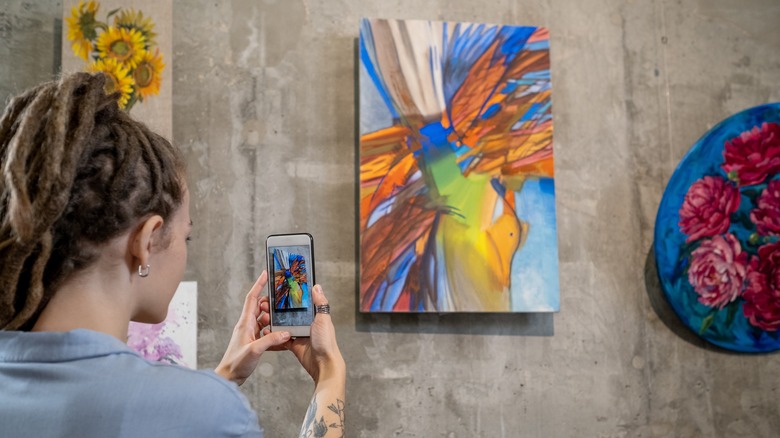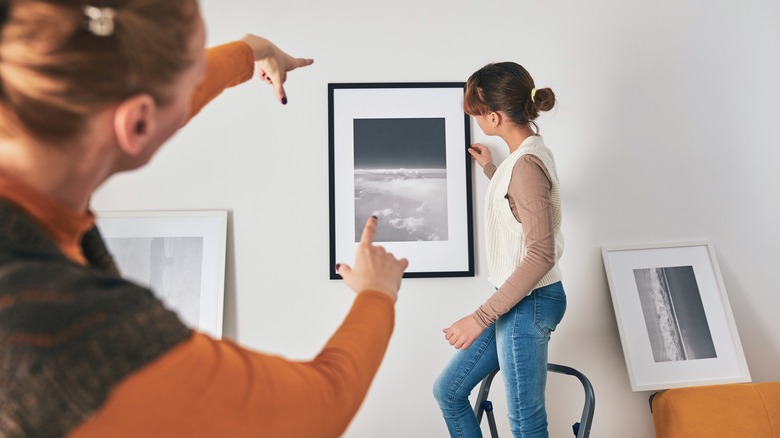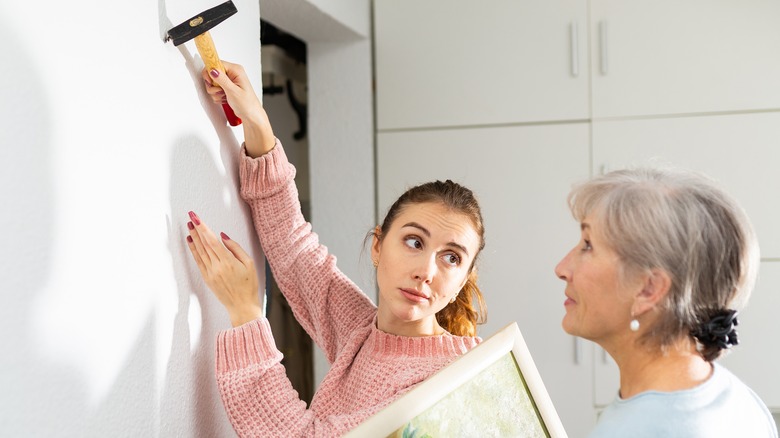How To Start Your Own Art Collection To Display In Your Home
We may receive a commission on purchases made from links.
For some people, collecting is an impulse; for others, an enigma. Enthusiasts argue, as Wondrium Daily did, that picking up and keeping certain objects because of their shared qualities is a fundamental instinct akin to the desire for creative expression. Established art collectors, per .ART, almost all have an apocryphal anecdote about the tat they accumulated as kids — as if their journey from bottlecaps to Basquiats was a straight, narrow, and easy road.
The psychology of collecting and the anthropology of the art market are too complicated to discuss here properly. But in simple terms, per The New York Times, the line between collectors and hoarders is where the idea of displaying or sharing the collection gets lost behind the drive to collect more and more. Yet it is through the process of collectors sharing their collections that we end up with the multi-faceted monster that we call the art market. Market power has always impacted modern taste, even if you have zero interest in art finances.
The internet and social media have only sped up and spread this effect; there are now more potential art buyers than ever, according to former Christie's President of the Americas Doug Woodham (via Artsy). This has led to volatility and a lot of news coverage, making starting your art collection seem even more daunting. Here are simple steps to get started on the road to your own Smithsonian.
Look, look, and look again
In "On Writing," Stephen King told authors, "If you don't have the time to read, you don't have the time (or the tools) to write. Simple as that." Advice like this can be found across the arts, and art collecting is no different — although instead of reading books, collectors are advised to look at as much art as possible and interrogate what it makes them feel. A decade ago, that would have meant physically standing in front of paintings and sculptures at galleries and shows, and that is still the best place to begin, according to Artwork Archive.
However, per Hiscox, recent years have seen a significant shift in the art market towards online purchases — 47% of young collectors bought their first-ever artwork online in 2022, up from 30% in 2020. This doesn't mean in-person viewings are worthless, but developing an eye for online and offline pieces will probably be an essential skill as you continue collecting. The first step in starting your art collection is still looking at a lot of art. Most of us will do this via the internet, which can be overwhelming and unproductive. If it is possible, use these tools to compare and contrast experiences. Visit an exhibit online before or after going in person, and take note of the differences in how pieces impact you. This type of self-reflection is at the core of a well-curated collection of anything.
Color and complexity — rules of thumb
Firstly, when in doubt, trust color. A 2018 study published in the Journal of Consumer Research explored the choice between brightly colored and drab products. They found that people generally overestimate how much bright colors will bother them in the future and that the owners who choose colorful options underestimate how much delight they will get over the objects' lifetime. This doesn't mean you should create a technicolor nightmare, but if a piece's color vibes with you, trust that instinct rather than worrying about it.
Secondly, find the complexity sweet spot. Libraries have been filled with discussions on the links between art, nature, and the human brain. A 2022 study out of Johns Hopkins saw a 'Goldilocks effect' where humans prefer images that are neither too simple nor too complex, but the less ordered the picture, the less observable this effect was. Another 2020 study from Northwestern University found that people consistently preferred images with the highest level of "organized complexity," which means the kinds of hierarchies, fractals, and beauty we love to see in nature. They found that images didn't need to make sense to the viewer to benefit from this effect. For example, Piet Mondrian's work is a modern, abstract version of nature's simple, organized complexity (via CultureTrip).
Collect with intention
John Russo, CEO of London's Maddox Gallery, told Gentleman's Journal, "whenever you buy artwork, it will serve two functions. It's either telling a story about you; or it's providing you with a story you want to tell about the piece." For most people, their own story is the best place to begin searching for art to collect. Finding affordable ways to start your own art collection is nothing short of a call to adventure and self-discovery. Cultural identity is one place to begin your search. Organizations like Artists at Risk sell prints from Ukranian, Syrian and Romani artists whose lives and cultures are under attack.
Closer to home, the Native American and Indigenous art scene is thriving, yet their work is still, as a general rule, underpriced and overlooked by collectors (via Artsy). The market for Black art has exploded in the wake of the ongoing Black Lives Matter movement, and, according to the Financial Times, the work of collector-activists such as Ms. Pamela Joyner fighting to get galleries to show Black art and artists the respect they deserve. Another sensible move is to find quality prints from artists you enjoy. "Nothing kickstarts an art collection like prints," according to Russo — with their lower price point, they can be a great way to form the core of a collection quickly and inexpensively. No matter how you start, the most important thing is to take the first steps. It's incredible how things can snowball from there.
Designing your gallery
Per Art Market Monitor, the difference between art pieces in the same room and an actual art assemblage is that a collection speaks. It tells many stories: that of each piece, each artist, and the collector. Displaying your art collection is a crucial step in telling that story. Small, focused collections have maximum impact in a dedicated space, but larger curations should be spread throughout the house to create a sense of harmony and cohesion from room to room, via The Seattle Times.
In some situations, juxtaposition can work well; that's why so many people have toys, sporting memorabilia, or pop-culture items in their home office. In other cases, pieces add depth to the existing purpose of a space — a collection of vintage car repair manuals in a workshop or decorative plates displayed in the dining room. When choosing a location for your art, it's also essential to consider the lighting, contrasting materials, colors, and focal points of your spaces, via Mountain Living. For example, a well-lit piece at eye level at the end of a corridor will draw attention, even more so if it contrasts with the wall behind it. Place significant pieces in locations like this, and fill transitional spaces like hallways and staircases with smaller, more eclectic pieces.
Showcasing your collection: the technicalities
Deciding where you'd like your art in your home is one step, but getting it to stay there safely is another. Remember: Art doesn't have to be framed to be displayed well. Traditionally framed and hung pictures can cause damage to the wall via nails or sun discoloration, which can cause friction for people with landlords. For new collectors especially, hanging pictures from the wall can be a big commitment, one they would prefer to delay until they have developed a better sense of style and what they enjoy. However, don't sleep on professional framers. According to Artists Network, framers are often overlooked. Still, their careers are built on displaying art well, and their advice can be invaluable even to experienced artists. Building a relationship with your local framer can be an excellent idea.
Frameless flexible, frame-optional, and renter-friendly options include shelves, mantelpieces, bulldog clips, or even just leaning against a wall, via Affordable Art Fair. According to Martha Stewart, the most common way to avoid nails is to use command strips, a hook-and-latch adhesive tape that securely holds the artwork on the wall but doesn't damage paint or the underlying drywall. The Artling advised planning your display on the floor before finally hanging anything. This will allow you to see any nuances of light you might have missed and to make fine adjustments before committing completely.





